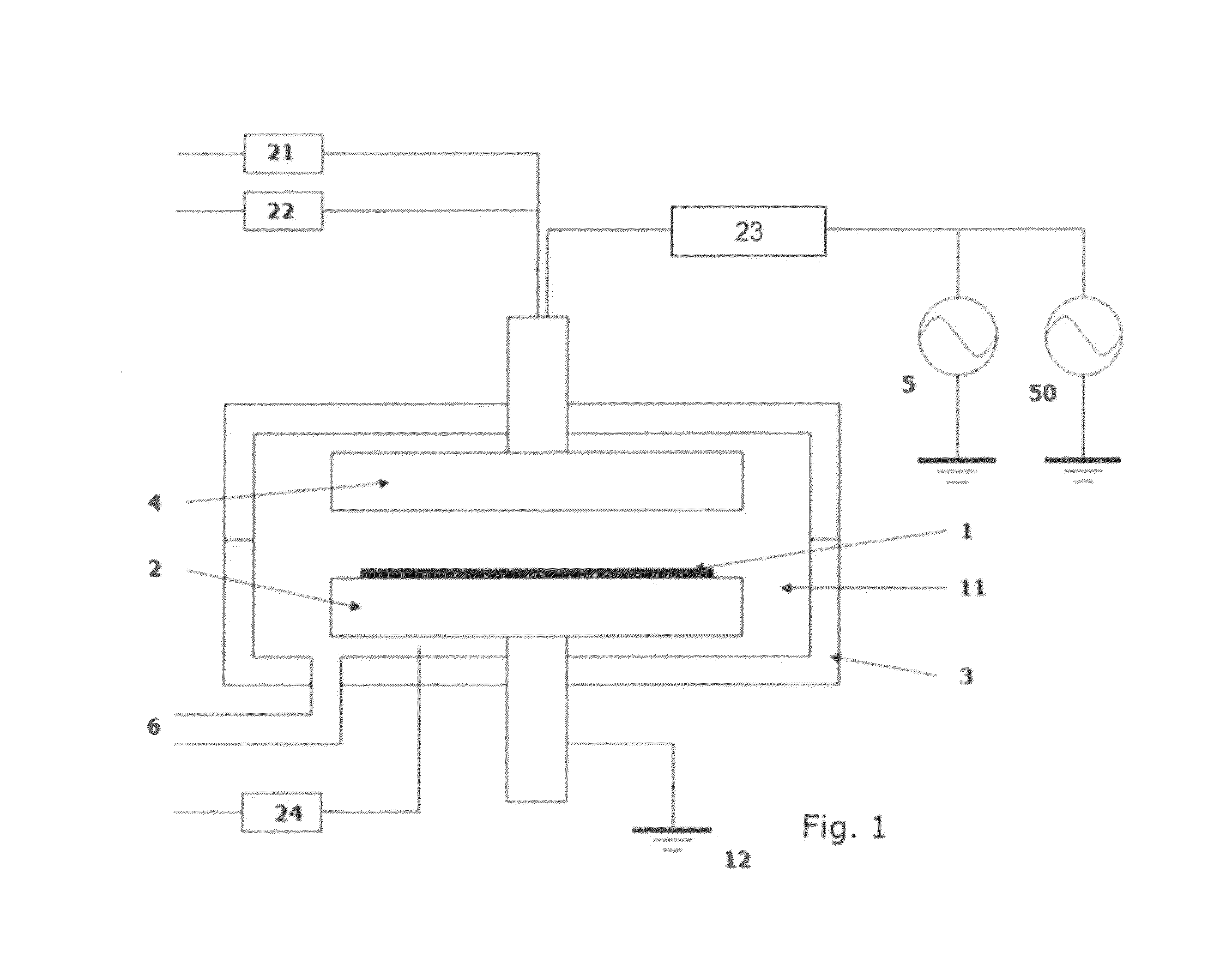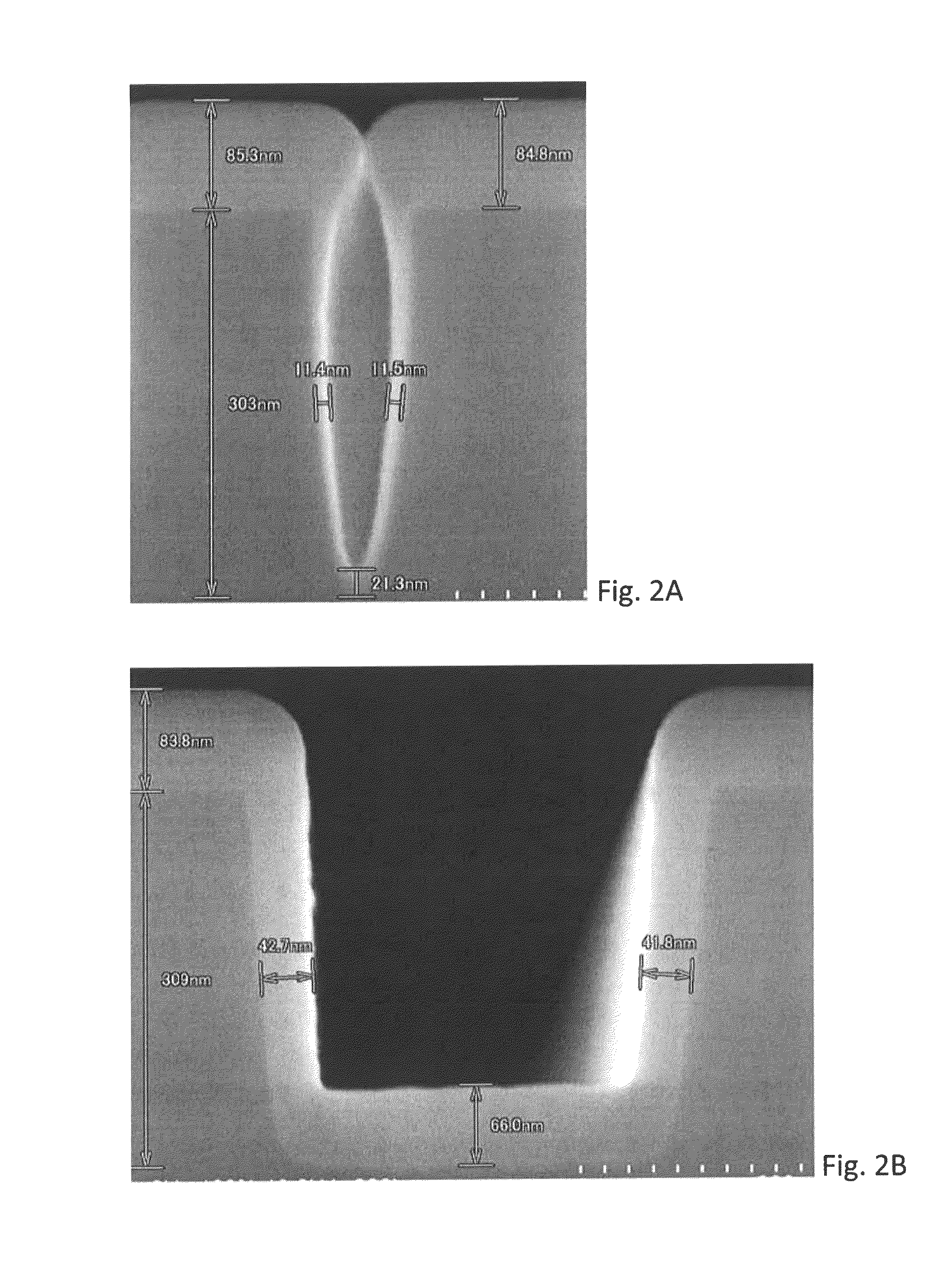Method for forming film by plasma-assisted deposition using two-frequency combined pulsed RF power
a plasma-assisted deposition and dielectric film technology, applied in chemical vapor deposition coatings, coatings, electric discharge tubes, etc., can solve problems such as expansion, cracking, and air gap structures subject to defects, and achieve the effect of film quality
- Summary
- Abstract
- Description
- Claims
- Application Information
AI Technical Summary
Benefits of technology
Problems solved by technology
Method used
Image
Examples
example 1
[0062]A dielectric film was formed on a 300-mm substrate having a patterned surface having an aspect ratio of 3.4 and an aspect ratio of 0.8 and an opening width of approximately 50 nm and approximately 230 nm, respectively, under the conditions shown below using the PECVD apparatus illustrated in FIG. 1. HRF and LRF pulse patterns were set as illustrated in (a) of FIG. 6 (100% overlap).[0063]Precursor: SiH4 [0064]Precursor inflow pressure: 300 Pa[0065]Precursor flow (continuous): 100 sccm[0066]Additive gas: N2O[0067]Additive gas flow (continuous): 4,000 sccm[0068]Substrate temperature: 400° C.[0069]HRF frequency: 13.56 MHz[0070]HRF power: 300 W[0071]LRF frequency: 430 kHz[0072]LRF power: 300 W[0073]HRF / LRF ON time: 0.3 milliseconds (Duty ratio: 30%)[0074]HRF / LRF OFF time: 0.7 milliseconds (Cycle: 1.0 milliseconds)[0075]Deposition time: 0.5 minutes
[0076]As a comparative example, a film was formed under the same conditions except that HRF and LRF powers were continuously applied with...
example 2
[0080]A film was formed in a patterned recess having an aspect ratio of 3.4 (AR3.4) of a substrate under the conditions which were the same as in Example 1 except that the duty ratio and the cycle (a period of one cycle) of HRF and LRF were adjusted as shown in Table 2 below. The step coverage (S / C) of each resultant film is shown in Table 2.
[0081]
TABLE 2Step CoverageRF-Duty Ratio [%]Cycle [msec]103050100cont.13.5%10—20.9%—13.5%2—20.0%—13.5%121.9%18.9%18.3%13.5%0.5—19.0%—13.5%0.1—14.7%—13.5%
[0082]As can be seen in Table 2, the step coverage was improved when using the two-frequency combined pulsed RF power, wherein the longer the cycle, and the smaller the duty ratio, the higher the step coverage improvement became.
example 3
[0083]A film was formed in a patterned recess having an aspect ratio of 3.4 (AR3.4) of a substrate under the conditions which were the same as in Example 1. The obtained film was analyzed with respect to wet etch resistance (etch rate (nm / min) when dipped in a solution of 130 BHF for 60 seconds) of a section of the film deposited on a top surface of the substrate, and of a section of the film deposited on sidewalls. The results are shown in Table 3.
[0084]
TABLE 3Δ130BHF (Dip Time 60 sec)TopSideSide / Top[nm][nm]RatioHRF / LRF cont.16.722.21.33HRF / LRF pulse25.321.40.84
[0085]As can be seen in Table 3, when the two-frequency combined continuous RF power was used, the film formed on the top surface was hard whereas the film formed on the sidewalls was soft, and thus, the ratio of top wet etch rate to side wet etch rate was as high as 1.33, indicating that the side film was etched significantly faster than the top film. In contrast, when the two-frequency combined pulsed RF power was used, th...
PUM
| Property | Measurement | Unit |
|---|---|---|
| frequency | aaaaa | aaaaa |
| frequency | aaaaa | aaaaa |
| aspect ratio | aaaaa | aaaaa |
Abstract
Description
Claims
Application Information
 Login to View More
Login to View More - R&D
- Intellectual Property
- Life Sciences
- Materials
- Tech Scout
- Unparalleled Data Quality
- Higher Quality Content
- 60% Fewer Hallucinations
Browse by: Latest US Patents, China's latest patents, Technical Efficacy Thesaurus, Application Domain, Technology Topic, Popular Technical Reports.
© 2025 PatSnap. All rights reserved.Legal|Privacy policy|Modern Slavery Act Transparency Statement|Sitemap|About US| Contact US: help@patsnap.com



